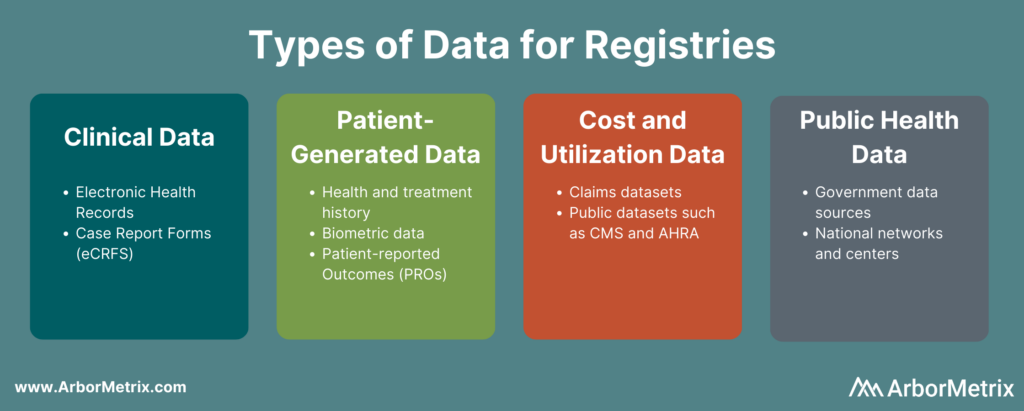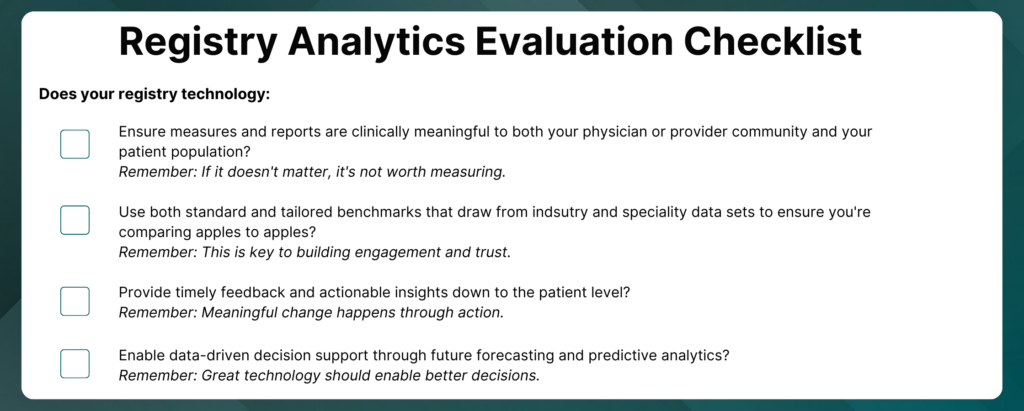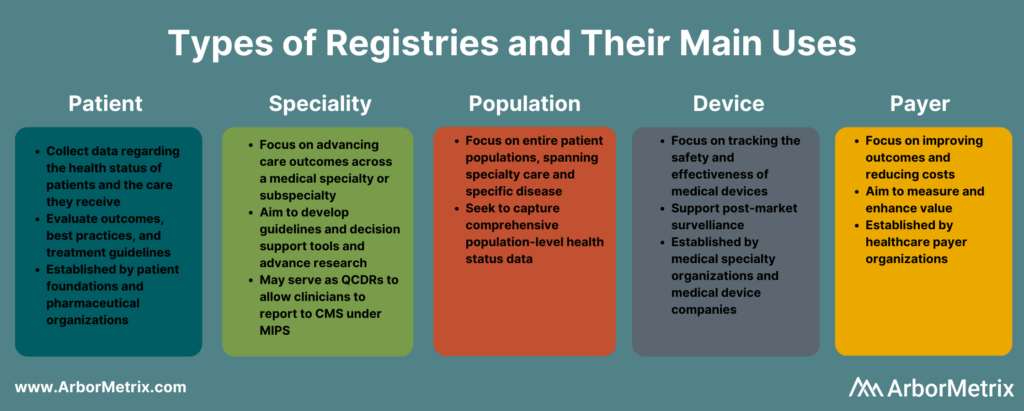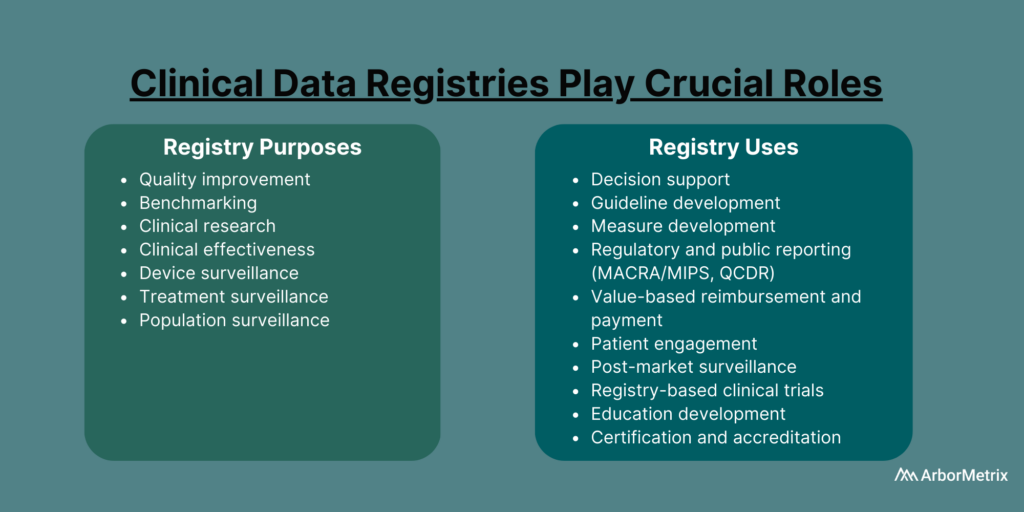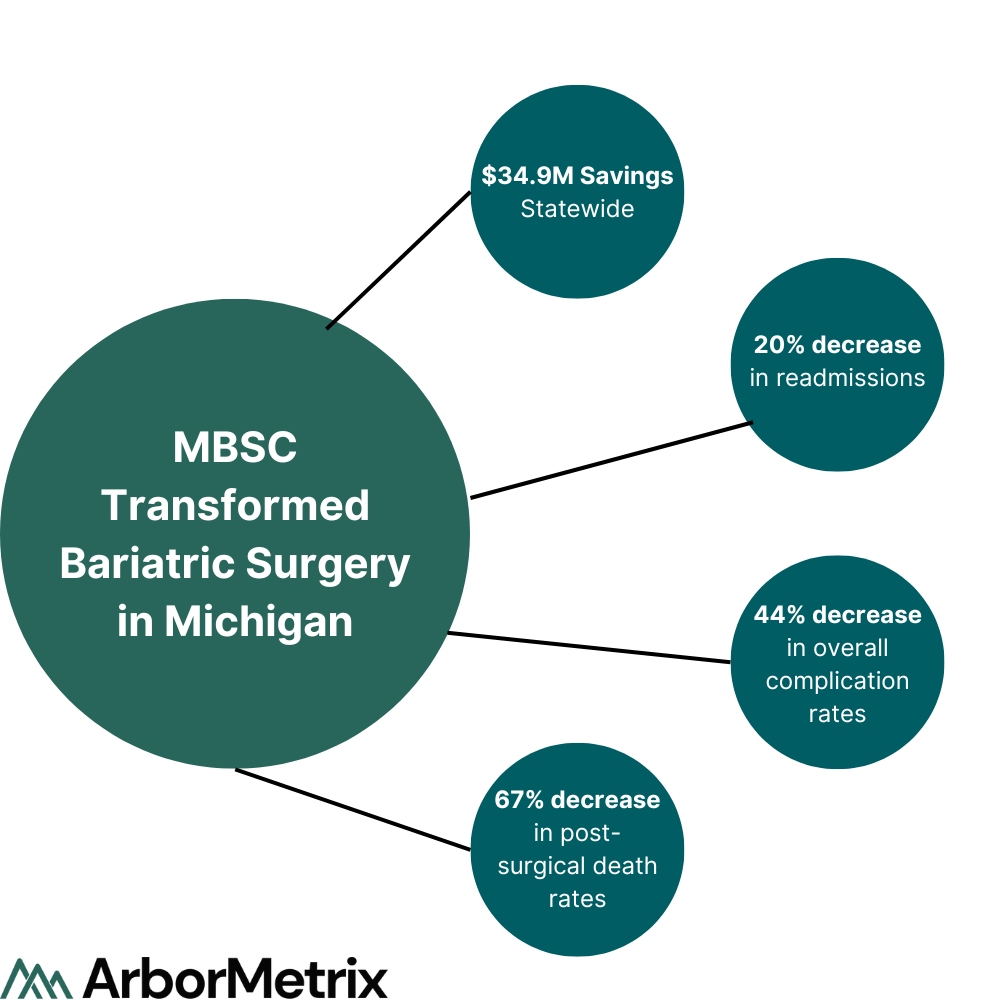3 Technology Essentials for Clinical Registries that Improve Care

Improving care seems like a monumental undertaking. It sounds expensive. It sounds overwhelming. But the good news is, if you have a clinical data registry, improving healthcare delivery and advancing research has never been more achievable.
Here are three technology essentials to consider when designing, building, and managing a clinical registry that will get you moving closer to measuring and improving care.
Using Healthcare Analytics for Clinical Registries
Running a successful clinical registry, also called a patient registry or disease registry, is a significant undertaking that requires the right technology and the right approach. Today’s most valued and most effective registries use healthcare analytics that go beyond data hoarding and warehousing, and set the stage to play a crucial role in advancing care and research.
Specifically, registry technology should cover three essentials:
- Integrate: Efficiently and securely acquiring and validating healthcare data from various sources.
- Identify: Advanced analytics are used for building trust in the data and uncovering drivers of outcome and variation.
- Inform: Delivering insights via interactive reports and tools that inspire data-driven action.
3 Keys of Registry Technology
1. Integrate: Collecting and Validating Data with Clinical Registry Software
Successful data acquisition creates a complete (and sometimes large) data set. Key aspects of this step include data sources, data integration technologies, and validating data for quality.
Registry Data Sources
Registries that achieve measurable results rely on a diverse and complete data set. They harmonize data from many sources, including:
- Clinical data from electronic health records (EHRs) and case report forms (eCRFs).
- Patient-generated data from patient-reported outcome (PRO) surveys.
- Cost and utilization data from claims and public datasets.
- Public health data from various government data sources.
Data Integration Technologies
In order to drive participation and value, registries must use efficient electronic data collection methods that ingest, validate, and transform data into a high-quality asset.
- Ingest: Deploy standards-based, vendor-specific, and custom connectors to ensure interoperability across EHR and other systems and sources.
- Validate: Ensure data completeness, correctness, and accuracy.
- Transform: Assemble and organize data into a single consistent representation.
Importantly, successful registries should base their data acquisition strategy on their goals and purpose – not just the data most readily or easily available to them. Focusing on what you need rather than on what you can get will point your registry in the most successful direction.
2. Identify: Analyzing Healthcare Data to Uncover Opportunities
Applying advanced analytics ensures data and reports are credible and trusted. When it comes to building engagement in trusted data, analytics make the difference. Here are a few specific methodological and statistical tools your registry should use.
Risk Adjustment
Risk adjustment is a process that corrects for the severity of a patient’s illness. Adjusting for risk levels the playing field and ensures that comparisons of hospitals and clinicians are fair and accurate. For example, our registries use scientifically and clinically validated statistical risk models to evaluate – in real-time – all factors related to each outcome. This builds trust.
Reliability Adjustment
In healthcare quality measurement, when sample sizes for a hospital or clinician are small, the observed rates or rare outcomes may be due to chance and should be considered less precise than rates based on larger sample sizes. Reliability adjustment is a statistical technique that is designed to isolate the signal and reduce the noise in your dataset. Specifically, our methods will determine whether outcomes are due to chance or true differences in quality.
If you want to learn more about risk and reliability adjustment, check out this post: What Are Risk and Reliability Adjustment and Why Do They Matter?
Benchmarking
Healthcare benchmarking means comparing a hospital or practice, or clinician, to others. Your registry should provide benchmarking based on patient characteristics, condition, geography, facility type, or other meaningful groups. It’s smart to also blind these benchmarks to protect privacy while still supporting effective measurement.
Peer Group Definition
Peer groups are an important part of benchmarking. Look for reporting and peer benchmarking capabilities at the clinician, practice, multi-practice, multi-facility, and organization levels.
If you want to learn more about benchmarking in healthcare, check out this post: What Is Healthcare Benchmarking?

3. Inform: Delivering Insights and Leveraging Evidence
While leveraging analytics and data science unleashes the value of your registry data, making those insights and reports accessible, engaging, and easily understood unlocks exponential value for your organization.
To make those insights as valuable as possible, aim to prioritize the user experience. You’ll want to think of your registry participants and end users as people who have a wide exposure to a variety of digital experiences. That means that when it comes to engaging with your registry, participants:
- Expect the same technological experience as their favorite apps or websites.
- Share and/or use information when it is convenient and compelling.
- Need their experience to be valuable.
When you focus on user experience, it ensures that every person can get value from the data, whether their needs are simple or complex. We’ve designed reporting features in our registry platform to drive engagement and support data-driven decision making. A few of the specific reporting features we use in our registry platform to drive patient engagement and support analysis include:
- Intuitive Views: Analyze data at the patient, provider, or site level, either individually or in aggregate.
- Flexible Interaction: Explore data at a deep clinical level by creating custom patient cohorts, analyzing case-level details, and drawing correlations within and across diagnoses.
- Personalized Visualizations: Perform complex analyses and create powerful visualizations using embedded Tableau.
- Custom Queries: Extract raw or analyzed data for special research projects or reports.
If you want to learn more about our user-centered approach to healthcare analytics software design, check out this post: Designing Healthcare Analytics to Engage Clinicians.
Registry Analytics Checklist
How do you use analytics to ensure measurement is fair, trusted, and engaging?
Download this checklist to help you evaluate your registry analytics.
Other Interactive Experiences for Registries
Beyond reporting and data visualizations, registries can harness emerging tools and technologies to add utility and value to their programs.
Patient Engagement and Patient-Reported Outcomes
Patient data informs a more complete view of quality, smoothing the gaps between clinical visits documented in the EHR, and helps you achieve even greater results. Modern patient-reported outcomes surveys and engagement tools allow you to collect the right data from the right patient at the right time.
Clinical Decision Support
Bringing together clinical data and patient-reported outcomes creates a powerful asset. Outcomes calculators use predictive analytics to intelligently combine registry data to predict outcomes, risks, and results of procedures, therapies, and treatments. This enables physicians to make data-driven decisions and empowers patients to engage in informed conversations about their outcomes.
Merit-based Incentive Payment System (MIPS) Reporting
Supporting CMS quality reporting not only drives quality improvement but also extends business value to registries. Physicians and other providers can use registries to report under the CMS MIPS program across all reporting categories, via a Qualified Clinical Data Registry (QCDR) or Qualified Registry (QR). By selecting and reporting on meaningful, clinically-relevant measures, monitoring performance rates, and reviewing estimated MIPS scores, they will understand their expected reimbursements in these programs.
Putting It All Together
These three essential steps to a successful registry are complex but achievable. ArborMetrix has built strong partnerships with our clients that put acquiring, organizing, analyzing, and acting on data at the center of their registry strategy.
Our clinical registry platform and our strategy and partnership, put these goals in their grasp. We bring our proven strengths in delivering clinical data registries that lead to scientific findings and actionable insights that have a real impact on real people.
The Basics of Clinical Data Registries

Healthcare’s digital transformation is long underway, yet still lagging. Calls for better and more efficient care, therapies, and outcomes have never been louder and more insistent. The role of clinical data registries has never been more significant.
It’s necessary to understand the importance of registries and how they make sense out of large volumes of disparate healthcare data to measurably improve care and advance research.
Let’s cover the basics:
- What Is a Clinical Data Registry?
- Types of Clinical Registries
- Purpose and Uses of Clinical Data Registries
- The Value of Clinical Data Registries
- Examples of Quality Improvement with Clinical Data Registries
- Example of a Medical Device Registry
- Getting Started with Clinical Data Registry Software Solutions
What Is a Clinical Data Registry?
A clinical data registry is an interactive database that collects, organizes, and displays healthcare information.
Clinical data registries are also sometimes called patient registries and disease registries. Professional medical associations and specialty societies tend to use the term clinical data registry, while research and patient foundations and government organizations lean toward patient registry. Because disease registries sound condition-specific, that term is often more popular with industry.
Regardless of the name, the purpose of a data registry is the same: to evaluate and improve outcomes for a population defined by a particular condition, disease, or exposure.
Specifically, registries use observational study methods to collect and harmonize data about the treatment, outcomes, and well-being of patients who receive care over time. They aggregate large data sets and analyze trends or patterns in treatments and outcomes.
Registries can serve many purposes and provide value for a variety of healthcare stakeholders. For example:
- Physicians and other healthcare professionals use registries to evaluate available treatments, procedures, and therapies, and to understand how patients with different characteristics respond to various treatments.
- Medical device manufacturers and pharmaceutical developers use registries to track and understand the effectiveness, safety, and value of medical devices or therapies and drugs entering or on the market.
The number of registries has grown over the past several decades as healthcare information has become digitized. Yet despite their increase in use and significance, registries face real challenges in establishing the participation, engagement, and utility needed to drive their sustainability.
Modern clinical data registries address these limitations by going beyond data collection and data warehousing. They rely on advanced analytics and data science to transform data into meaningful insights that are useful, usable, and used by a variety of stakeholders to achieve a desired outcome.
Types of Clinical Registries
Clinical registries come in many different forms. The type of registry depends on the organization managing or sponsoring it, and the patient population, disease, condition, or treatment it examines.
Although registry goals and purposes vary, when designed with the right approach and built with the right analytics technology, they can measurably improve care.
What Is a Patient Registry?
A patient registry, also called a disease registry, tracks information about the health status of patients and the care they receive for a specific disease or condition. Patient registries bring together data to evaluate longitudinal outcomes, best practices, treatment guidelines, and to support research and therapeutic development.
A growing number of patient foundations and pharmaceutical organizations are establishing patient registries to study the treatment of rare diseases and conditions, such as hemophilia and other genetic diseases.
What Is a Specialty Registry?
Specialty registries are clinical registries focused on advancing care and outcomes across a medical specialty or subspecialty, such as pathology, sleep medicine, surgery, and trauma medicine. These registries often aim to develop guidelines and decision support tools, accelerate research, and advance care through collaborative quality improvement. Specialty registries also provide a mechanism for physicians and providers to report to the Centers for Medicare and Medicaid Services (CMS) under the Merit-based Incentive Payment System (MIPS) as Qualified Clinical Data Registries (QCDRs).
What Is a Population Registry?
A population registry is more broadly focused across entire patient populations and spans both specialty care and specific diseases and conditions. These registries aim to capture the health, well-being, diagnostic, treatment, and outcome data for every patient within a population defined by demographics (age, gender, or other social determinants), geography (state, region, country and including like Health Information Exchanges and within Health Departments), or disease or condition (diabetes, cancer).
What Is a Medical Device Registry?
A medical device registry is focused on tracking the effectiveness, safety, and value of medical devices. Device registries come in several forms. Medical specialty organizations may collect data on various devices used for procedures or conditions, as part of their clinical data registries. Medical device companies establish registries and use registry data to support post-market surveillance.
What Is a Payer Registry?
A payer registry is established by a healthcare payer focused on measuring and improving value by advancing outcomes and reducing costs. Payer-sponsored registries are often organized across a specific geography or region, and by specialty – surgery, urology, emergency medicine, etc.
Purpose and Uses of Clinical Data Registries
Healthcare organizations such as medical specialty societies, patient foundations, pharmaceutical companies, and medical device manufacturers establish registries for many purposes and uses.
Clinical Data Registry Purposes
- Quality improvement
- Benchmarking
- Clinical research
- Clinical effectiveness
- Cost effectiveness
- Device surveillance
- Treatment surveillance
- Population surveillance
Clinical Data Registry Uses
- Decision support
- Guideline development
- Measure development
- Regulatory and public reporting (MACRA/MIPS, QCDR)
- Value-based reimbursement and payment
- Patient engagement
- Post-market surveillance
- Registry-based clinical trials
- Education development
- Certification and accreditation
The Value of Clinical Data Registries
Clinical data registries are valuable when they measurably improve care and achieve results. Examples of this in action are advancing research, establishing and evaluating guidelines, or managing and reducing costs.
Achieving value with a registry happens when:
- Physicians and providers use high-quality, data-driven insights to better understand expected outcomes, make evidence-based decisions, and share best practices.
- Patients share timely and personal data about their condition and outcomes and gain a greater understanding of their care that leads to informed shared decision-making.
- Researchers and developers use registry data as the foundation for registry-enhanced or registry-based research, clinical trials, or post-market surveillance studies.
Examples of Quality Improvement with Clinical Data Registries
In 2019, the Michigan Surgical Quality Collaborative (MSQC) used registry data to generate knowledge in the form of procedure‐specific opioid prescribing guidelines.
The result?
Post-surgical opioid prescribing dropped by 30%, and post-surgical patient opioid consumption dropped by 50%, according to a paper published in the New England Journal of Medicine. There also was no change in patient-reported satisfaction with care and pain in the week after surgery.
The Pediatric Cardiac Critical Care Consortium (PC4) aims to improve the quality of care for pediatric heart patients through a clinical data registry that allows hospitals to evaluate their own outcomes and learn best practices.
Their efforts are paying off.
Eighteen hospitals significantly reduced mortality and improved care for children with critical heart conditions, according to a paper published in the December 2019 edition of the Journal of the American College of Cardiology. Specifically, they achieved a 24% decrease in postoperative mortality among participating sites between 2014 and 2018.
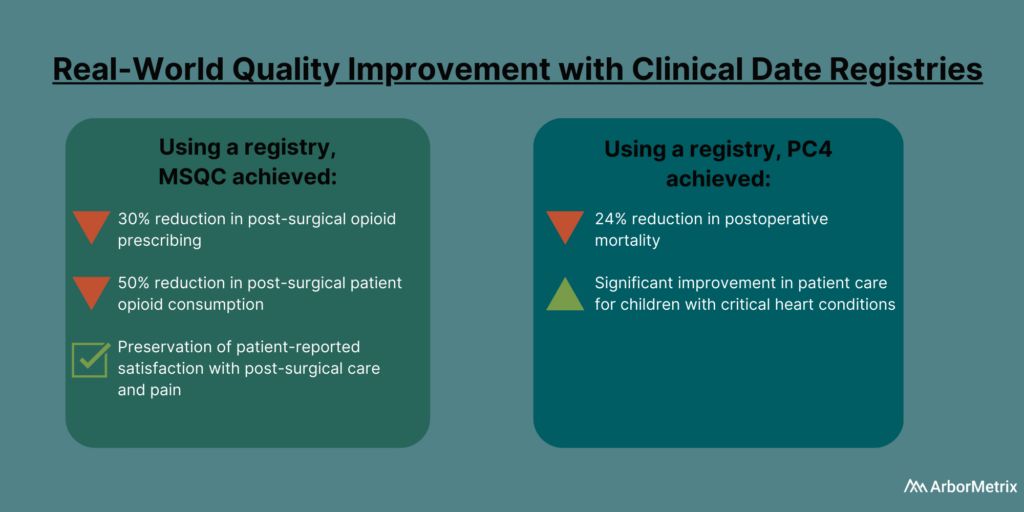
If you want to know more, read this post about how MSQC and PC4 are top examples of quality improvement in healthcare.
Example of a Medical Device Registry
Clinical registries sponsored by medical specialty societies and patient advocacy organizations are proving to deliver tremendous value in tracking and measuring the effectiveness of medical devices and drugs. Medical device and pharmaceutical developers leverage registry data to gain insights into how their products actually perform in the real world.
For example, the Extracorporeal Life Support Organization (ELSO) aimed to transform its international medical device registry into a rich data asset for ECMO device manufacturers. Through real-time access to device usage and outcomes data, coupled with advanced analytics and reporting services, device manufacturers have the tools they need for data-driven research and development, rapid regulatory submissions, and cost-effective registry-based clinical trials.
Read more about how ELSO’s global medical device registry, helps bridge the gap between what really happens in healthcare and what is “supposed” to happen by turning real-world data into real-world evidence.
Getting Started with Clinical Data Registry Software Solutions
Today’s most successful clinical data registries use healthcare analytics technology that goes beyond data collection and data warehousing and plays a crucial role in advancing care and research.
Specifically, a clinical data registry platform should:
- Acquire various data using industry-leading technology and standards.
- Assemble the data into real-world evidence using advanced analytics and data science.
- Enable various users to act on the evidence using dashboards, reports, surveys, and other unique decision-support tools.
There is a lot that goes into each of these 3 essential building blocks. Read this post to learn more about designing a patient registry to improve care.
Leverage the Power of Clinical Data Registries
The National Quality Registry Network outlines some key considerations when approaching a clinical data registry and deciding what to outsource to a vendor. This includes your in-house availability and expertise, budget impact, convenience, and the many responsibilities that can be outsourced or kept in-house.
At ArborMetrix, we help healthcare organizations and companies demonstrate real and measurable results through robust analytics and intuitive reporting. Through our comprehensive partnerships and clinical expertise, we enable our clients to leverage their real-world evidence for real-world results.
How Registries Gain Momentum and Achieve Lasting Value

Here at ArborMetrix, we’re focused on creating and delivering powerful product roadmaps that align with the industry and the needs of our clients and partners. These roadmaps help prioritize work, set expectations, and point us ever forward, toward our long-term vision.
But, roadmaps aren’t simply our own internal tools. We often provide roadmaps to our customers for their clinical registries. These plans outline how to take their data and software assets to the next levels for their populations. To be effective long term, your registry must continually evolve to address the growing needs of your clinician and patient populations.
Clinical registries exist on a scale of momentum that spans three stages:
- Foundational
- Intermediate
- Advanced
We guide our registry partners through each stage and set a strategic plan to help them progress to their ultimate goals.
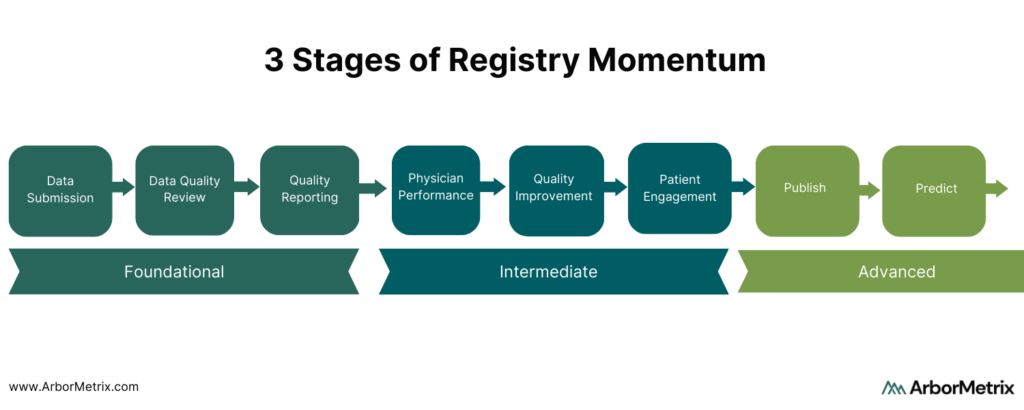 Foundational Registry Momentum: Data Submission, Data Quality Review, Standard Reporting
Foundational Registry Momentum: Data Submission, Data Quality Review, Standard Reporting
Foundational registry momentum is defined by the compelling business and market needs that drive a registry’s framework. Often the impetus is collecting data for regulatory or post-market reporting, with features that include:
- Collecting data through a variety of channels and formats.
- Ensuring data is high quality through a robust data dictionary and supporting validation logic.
- Standard report sets that support participation incentives – such as member performance through MIPS reporting, or device performance through post-market surveillance activities, among many others.
The Foundation stage is important because it serves to get data in the registry and drives membership and participation from affiliated organizations and clinicians. Most new registries achieve these goals within the first six months of launch.
However, if your registry launched a few years ago and you are feeling like your momentum is “stuck” or “limited” by not progressing past the Foundational stage, you’re not alone. This is a common situation that you can remedy with the right approach and technology.
Let’s continue with MIPS reporting as an example. Data required to support MIPS is not very rich, and users do not need to interact with a MIPS registry more than a few times a year. This process must be simple and convenient for users but does not drive deep engagement.
To get past this, identify new or additional goals and programs that your registry can achieve and support. This will move your registry forward and expand its value.
Intermediate Registry Momentum: Clinician Performance, Quality Improvement, Patient Engagement
The momentum of your registry is truly unleashed when it builds deeper engagement.
This begins when it is used to highlight and change behavior. Our registry product and services are purpose-built for deep analytics and actionable insights related to measurable clinician and device performance, quality improvement, and patient engagement.
- Clinicians and industry stakeholders engage when the registry can be used to highlight their performance relative to peers and within their health system or specialty.
- Quality improvement is realized when the registry can indicate areas where treatments and interventions can be improved, and where guideline adherence is tracked and analyzed for impact.
- Patients engage when they are given the opportunity to safely share their health and quality of life related to diagnoses, treatments, and interventions, and know that data can be used in shared decision making.
Most of our clients spend a significant portion of their registry’s lifecycle building and growing these intermediate assets. This starts with our goals-oriented implementation process. These features can propel the momentum into new and relevant measurement areas and reporting domains that keep a registry fresh and engaging over time.
Advanced Registry Momentum: Publish and Predict
Finally, let’s talk about the hallmark of registry success: The ability to use it as a platform to publish research and clinical practice guidelines, and to predict outcomes. Advanced registries also expand their scope of participation and achieve sustainability through data commercialization.
Here’s how they reach this level. Registries arm us with trusted insights on clinician and device performance and quality improvement in care delivery. They also inform the patient experience through patient-reported outcomes. Registry owners and stewards share this knowledge and insights with the broader community to extend its impact.
Clinical Research and Practice Guidelines
Our customers have published a rich portfolio of registry-based research. Importantly, we help them achieve rapid-cycle research. On average, our customers publish their first peer-reviewed publication using registry data within a year of launch.
This is not just within scientific and medical journals, but also with the creation and publication of new clinical practice guidelines. The rigorous scientific process that we apply to registry data makes it ideal for evaluating the standards of care and long-term outcomes that impact patients.
Predictive Analytics and Outcomes Calculators
Predictive analytics is when data science principles are applied to model and forecast outcomes and risks at the point of care. This allows clinicals to make treatment decisions with better insight and, ultimately, avoid complications and negative outcomes.
The most advanced registries we support utilize outcomes calculators. These are built on complex data and models that combine foundational data assets with longitudinal patient data. Outcomes calculators provide powerful tools for shared decision-making between providers and patients and provide long-term registry value.
Predictive Analytics Registry Example
One example of an advanced registry using predictive calculators is the Michigan Bariatric Surgery Collaborative (MBSC). MBSC aims to advance the science and practice of bariatric surgery. Registry data is used to feed the MBSC Predictive Outcomes Calculator, which is publicly available for clinicians to use to predict a patient’s weight loss, comorbidity resolution, and complication rate after bariatric surgery.
Specifically, the tool:
- Predicts weight loss at years 1, 2, and 3 for five different procedures using patient information on demographics, comorbidities, and risk factors.
- Predicts the likelihood of resolving weight-related comorbidities.
- Predicts the likelihood of minor and major complications.
Notably, the predicted rates for weight loss, comorbidity resolution and potential complications are patient-specific, using risk-adjusted, real-world outcome data from similar patients.
These tools and other quality improvement initiatives helped MBSC and its members decrease rates of VTE by 43% and decrease post-surgical death rates by 67%.
Achieve Lasting Value with Your Registry
It’s important to remember that registry momentum happens over varying spans of time.
Some registries have been around for many years, and their momentum has been focused on providing foundational value to its members. Other registries are only getting started and are already looking at how they can propel their programs by quickly predicting outcomes and publishing results.
Whatever stage in which your registry exists, we have both the vision and the delivery model to help you build momentum and achieve lasting value.
If you have any questions or would like to learn more about our clinical data registry solutions, contact me, Chrystal Price, M.S. at cprice@arbormetrix.com.
Designing Healthcare Analytics to Engage Clinicians

Healthcare analytics software enables the acquisition, validation, transformation, and visualization of robust data sets. Organizations use healthcare analytics for a wide variety of purposes, including:
- The business of healthcare that analyzes financial trends and access to services.
- The delivery of healthcare aimed at driving improvements to the quality of care and care providers.
- The monitoring of healthcare treatments like devices and pharmaceutical interventions.
While the use cases are incredibly diverse, they all share a few common requirements:
- A dedication to the strict adherence to standards that keep your data safe and secure.
- A streamlined process for collecting and blending disparate data sources into a unified whole.
- A focus on improving access and outcomes for the most important stakeholder – the patient.
In order to achieve these aims, healthcare data must be engaging and interactive to support key decisions. This is especially true for clinician users.
User engagement is a key indicator to help organizations understand how decision makers like clinicians are using healthcare data and applications. User engagement metrics tell us:
- The degree to which data-driven decision making is prevalent in an organization’s culture.
- The degree to which the healthcare analytics application facilitates simple and intuitive data exploration.
At ArborMetrix, we see it as our responsibility to facilitate delightful and engaging user experiences and ultimately to inspire and support a culture of data-driven decision making in healthcare.
User-Centered Design in Healthcare Analytics
When designing healthcare analytics software to drive clinician and end-user engagement, it is crucial to understand the value proposition for key user personas. These personas represent the types of users and stakeholders who will be interacting with the product.
We leverage user-centered design principles to define personas and engage in best-practice research methods like focus groups, user observation sessions, and surveys.
Every persona has high-value needs, and we focus on designing easy and intuitive user experiences to facilitate those needs. Some examples of personas for clinical registries include quality officers, administrators, clinicians, researchers, patients and caregivers.
We tailor our user interface and workflows to align with the needs of our users. We want to ensure that they have easy access to the information and tools that matter the most to them.
Designing Healthcare Analytics Tools for Clinician Engagement
Here are a few examples of high-value opportunities for engaging clinical personas:
- Easing the burden of regulatory reporting requirements.
- Enabling meaningful benchmarks based on timely data.
- Providing quick access to relevant measures with robust filtering for custom patient cohort comparisons.

For users tasked with providing data, we aim to make data acquisition seamless by utilizing electronic connections whenever possible. When manual data entry is necessary, product capabilities for intuitive smart forms with validation logic that are attune with user workflows are critical. This is to ensure high-quality data capture with minimal effort.
It is important to capitalize on the momentum from an initial rollout of new software and plan a product roadmap to maintain engagement with new high-value capabilities and insights. Planning for growth can include expanding the scope of measures available, growing the library of reports, adding support for new personas, and releasing new product features that align with high-priority user needs.
Healthcare analytics software, purpose-designed for your users, can help you go beyond understanding how you’re performing to exploring why. That’s what inspires data-driven action and measurable improvement.
To see our user-centered design in action and learn more about how we can help you meet your healthcare analytics and clinical registry needs, contact our team.
What Is Predictive Analytics and Why Is It Important?

Exploring data helps us understand our world. Why something happened, how things are trending, and what constitutes a meaningful change.
Now, we have a vast set of tools in our data analysis toolbox. We can not only examine what happened in the past, but we can also predict what might happen in the future using predictive analytics.
Predictive analytics is a powerful tool that can help us accelerate the path to healthcare value, ultimately reducing healthcare costs while improving patient care.
Read on for an introduction to predictive analytics in healthcare, including the uses, benefits, value, and potential future of predictive analytics.
In this post we will cover:
- What Is Predictive Analytics in Healthcare?
- What Is the Role of Predictive Analytics?
- What Are Use Cases of Predictive Analytics in Healthcare?
- What Is the Value of Predictive Analytics?
- What Is the Future of Predictive Analytics?
What Is Predictive Analytics in Healthcare?
Predictive analytics answers the question: what is likely to happen next?
Using modeling and forecasting techniques, predictive analytics helps determine what has a high probability of occurring in the future. Physicians, researchers, medical specialty societies, pharmaceutical companies, and every other healthcare stakeholder can then use those predictions to provide the best possible care for individual patients.
To provide the most robust predictions possible, predictive analytics uses a variety of modeling techniques, from traditional hierarchical linear models to advanced artificial intelligence (AI) and machine learning algorithms. AI is a collection of technologies that can think and adapt on their own, while machine learning, which is a subset of AI, involves generating models to describe data with greater and greater precision as more data is introduced. [1,2]
In healthcare, predictive analytics leverages AI and machine learning to analyze historical data and forecast outputs such as disease risk for individual patients. [3]
What Is the Role of Predictive Analytics?
Predictive analytics is quickly becoming a cornerstone of personalized healthcare.
Using AI and machine learning, predictive models can intake huge amounts of diverse data for a single patient and forecast a patient’s response to certain treatments or devices, their risk of developing a specific disease, and their prognosis for a given condition.
What is personalized healthcare? This customized way of treating a patient is rooted in that individual’s specific medical history, environment, social risk factors, genetics, and unique biochemistry, among other characteristics. The key to personalized healthcare is treating a patient based on their specific attributes, instead of relying on population averages that aren’t one-size-fits-all. [4]
Predictive analytics is helping the healthcare system shift from treating a patient as an average to treating a patient as an individual, which can only improve patient care overall in terms of quality, efficiency, cost, and patient satisfaction.
Use Cases of Predictive Analytics in Healthcare
Predictive analytics is useful at every step in a patient’s journey, including diagnosis, prognosis, and treatment. Predictive analytics can also inform remote patient monitoring and reduce adverse events. On a more macro level, predictive analytics can improve care quality while reducing costs.
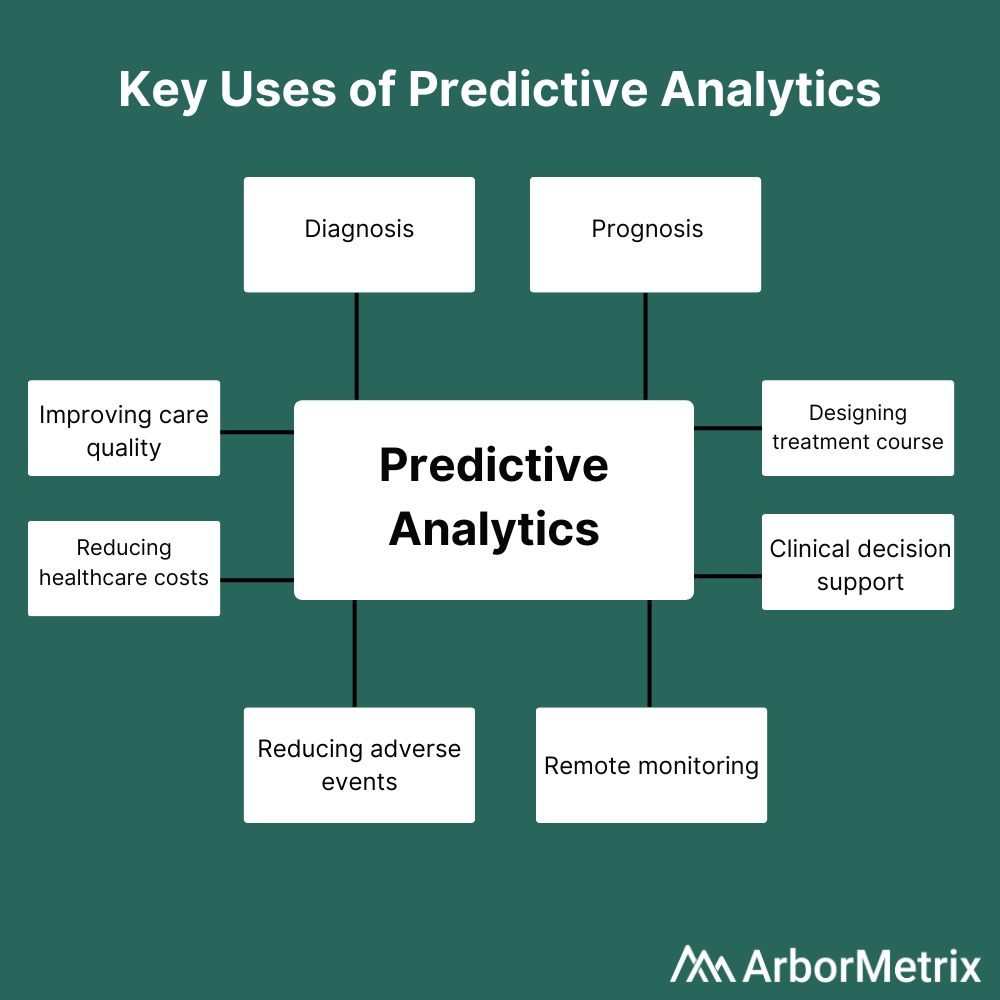 Leveraging predictive analytics can help answer questions like:
Leveraging predictive analytics can help answer questions like:
- What is the best course of treatment for this patient?
- Is this patient likely to experience an adverse event following a given procedure?
- What is the likelihood that this patient has a malignant tumor?
Here are a few key examples of predictive analytics in healthcare being used at various points in the patient journey:
- Diagnosis: Predictive analytics have been used to predict malignant mesothelioma diagnoses in a patient cohort. Patients diagnosed early can start treatment immediately, which improves their chances of survival—thus making prediction a critical tool. [5]
- Prognosis: Researchers used predictive analytics on physiological data from patients with congestive heart failure (CHF) to predict which patients were at greatest risk of readmission following a hospital stay. Using that information, physicians could implement interventions early to prevent the predicted readmissions. [6]
- Treatment: Clinicians have used machine learning-based predictive analytic models to determine the most effective course of treatment for chronic pain patients. [7]
Most importantly, predictive analytics can provide real-time clinical decision support at the point of care, making personalized healthcare as efficient as possible.
This is just a small sliver of the research being performed using predictive analytics in healthcare. As technology and analytic models advance, more opportunities to improve patient care using forecasting techniques will surely be discovered.
What Is the Value of Predictive Analytics?
Wherever there is data, predictive analytics can produce tremendous value. Leading organizations leverage predictive analytics to generate real-world results. Below, you’ll find two key examples of health industry players that have used predictive analytics to their advantage.
Example #1: Sound Physicians Uses a Predictive Analytics Tool, SoundPredict, to Determine Patients’ Readmission Likelihood
Sound Physicians is among the largest hospitalist, emergency medicine and critical care group in the United States and a leader in physician performance and analytics. Sound focuses its clinical strategy and resources on value-based payment models such as the Bundled Payment for Care Improvement–Advanced (BPCI-A) program. The goal of these programs is to reduce healthcare costs while improving patient outcomes.
To support participation in these programs, Sound relies on SoundPredict, a predictive analytic engine powered by ArborMetrix. This engine leverages rich clinical information from Sound’s 3,500+ clinicians to predict likelihood of readmission, program eligibility, and other condition-specific factors that inform clinical workflows. This tool helps Sound determine which patients receive certain interventions such as tele-SNF encounters, follow-up appointment scheduling prior to the patient leaving the hospital, and post-discharge telephone outreach from nurses and advanced-practice providers.
With SoundPredict updates, analytics reduced the predicted at-risk population by 17.5%. The narrower and more accurate the predicted eligible population, the better Sound can focus targeted interventions, manage resources, reduce costs, and improve outcomes for that patient group.
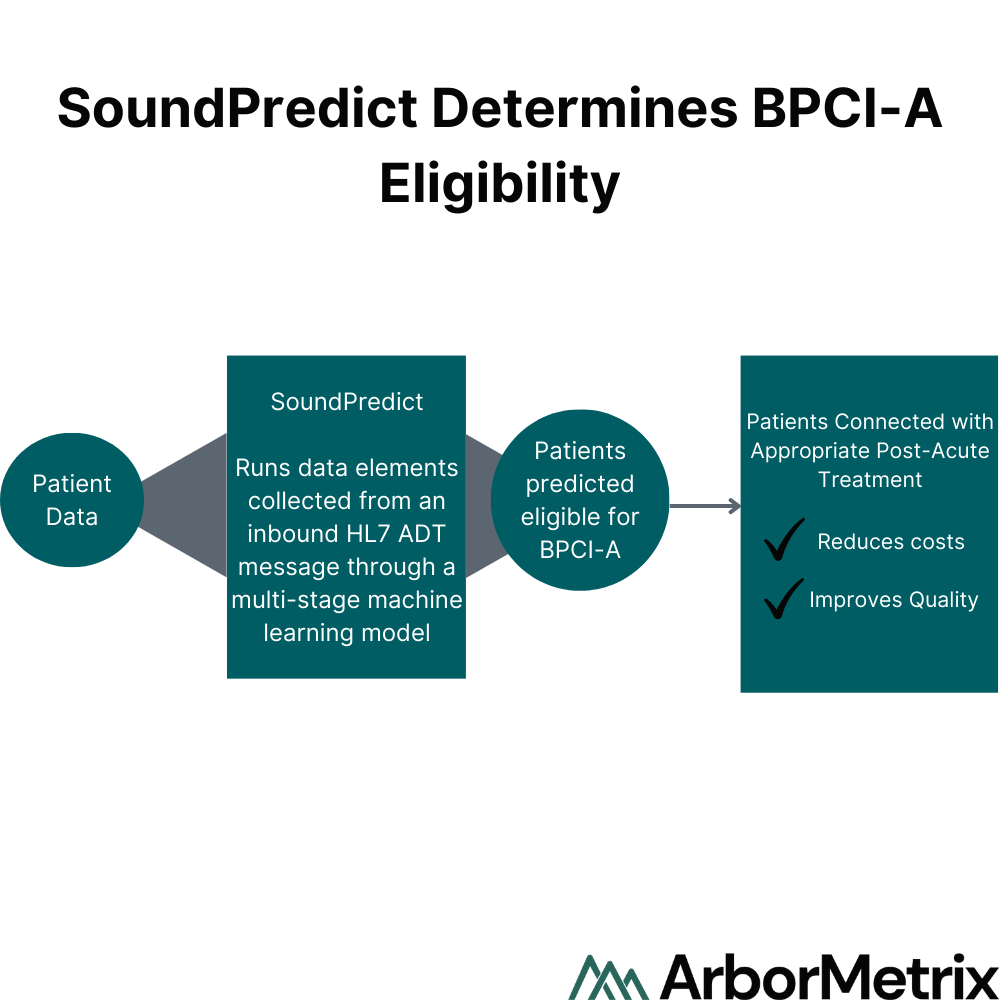 Example #2: Michigan Bariatric Surgery Collaborative (MBSC) Uses a Predictive Calculator to Forecast Bariatric Surgery Outcomes
Example #2: Michigan Bariatric Surgery Collaborative (MBSC) Uses a Predictive Calculator to Forecast Bariatric Surgery Outcomes
MBSC, a quality improvement collaborative funded by Blue Cross Blue Shield, leverages a powerful patient registry to improve bariatric surgery in Michigan.
MBSC uses clinical and patient-reported data combined with powerful predictive analytics to support clinical decision-making. Participating physicians use the MBSC registry and patient engagement tools to collect comprehensive preoperative data for potential bariatric surgery patients.
This data is then used to feed the MBSC Predictive Outcomes Calculator, a publicly available tool physicians can use to predict a patient’s weight loss, comorbidity resolution, and complication rate after bariatric surgery.
Specifically, the tool uses patient information on demographics, comorbidities, and other risk factors to forecast:
- Predicts weight loss at years 1, 2, and 3 for each of the available procedures.
- Predicts the likelihood of resolving weight-related comorbidities such as diabetes or sleep apnea.
- Predicts the likelihood of adverse events, serious complications and mortality.
Notably, the predicted rates for weight loss, comorbidity resolution, and potential complications are patient-specific, using risk-adjusted, real-world outcomes data from similar patients. These tools and other quality improvement initiatives helped MBSC and its members decrease rates of venous thromboembolism (VTE) by 43% and decrease post-surgical death rates by 67%.
What Is the Future of Predictive Analytics?
As we amass more and more data, predictive analytics will become both more common and more accurate.
Currently, many predictive models use traditional statistical methods, such as logistic regression, which are useful and can provide insightful results. However, AI and machine learning methods such as random forests, when implemented appropriately, can provide more accurate predictions. Ultimately, as more feature-rich data is collected and as the collection process itself improves, predictive analytics can take advantage of deep learning algorithms that can make better use of large and complex data sets. [8]
For example, deep learning algorithms can be used for image recognition, whether that be images gleaned from MRIs or other types of imaging technology, to automatically detect certain features. In contrast, a machine learning-based approach would require the radiologist to extract all the features from the image first. Deep learning simplifies the process by detecting all the features automatically, without requiring extra work by the radiologist.
Put simply, big data and predictive analytics in healthcare go hand in hand—more data means better predictions.
Additionally, the field of predictive analytics will advance to overcome its limitations. One current drawback is that predictive analytics is not able to provide insight into what might happen after an intervention or other change, which can be frustrating for researchers and clinicians who want to understand how patients might fare after a new treatment or as a result of a new hospital procedure. We expect predictive analytics will advance past this challenge, allowing researchers to forecast the future in a much more expansive and holistic way.
Predictive analytics will also be able to benefit from the massive leaps in computer processing power that make chewing through complicated algorithms possible.
Someday soon, predicting the future with accuracy under a variety of conditions will be the norm, not a fortune-teller’s trick.
Whichever Direction Your Predictive Analytics Journey Takes You, You’ll Need a Guide
If you have any questions or would like to see how the ArborMetrix predictive analytics solution can help you forecast the future, contact us.
The Top 3 Lessons for Registries from the CMSS Annual Meeting

The Council of Medical Specialty Societies (CMSS) held their 2020 Virtual Annual Meeting with the theme of Covid-19 and Beyond: Digital Transformation of Healthcare, Research, and Education.
The dynamic group of presenters and panelists covered a variety of topics that demonstrate how digital technology, such as clinical registries and healthcare analytics, can be instrumental in advancing healthcare.
Our key takeaway: The digital transformations that are needed to make these advancements are less about how people transform technology and more about how technology transforms people and lives.
Registries, for instance, can be used to help solve some of the most intractable issues in healthcare like:
- Addressing underlying root causes of health disparities.
- Making it easier for patients to understand, navigate, and manage their care.
- Monitoring and managing COVID-19 and other emerging priorities.
1. Addressing Root Causes of Health Disparities
There are widespread and longstanding health disparities among racial and ethnic minorities.
These disparities cause some populations to face unfair health burdens. Health is a fundamental human right, and consequently, healthcare stakeholders have an ethical obligation to ensure fair and just health experiences by acting to eliminate avoidable health disparities.
Clinical data registries are powerful tools for assessing health disparities, identifying the root causes, and tracking efforts to address health inequities. Importantly, these tools should provide actionable insight, as referenced by Rhea Boyd, M.D., M.P.H., Pediatrician and Child Health Advocate at Palo Alto Medical Foundation and UCSF Benioff Children’s Hospital.
This work includes implementing robust data logic rules to identify underperformance in need of equity-focused quality improvement efforts, as presented by Ernest Moy, M.D., M.P.H., Executive Director, Office of Health Equity, U.S. Department of Veterans Affairs. Those health equity efforts are made more effective with social determinants of health analytics that provide a comprehensive view of the interconnected factors influencing a patient’s health.
How Registries Can Advance Health Equity
Alongside several of our partners at medical specialty societies, we see the very real effects of longstanding and systemic health disparities – made evident through evaluating data in their registries.
Registries collect a high-volume of data from different sources and deliver high-quality, data-driven insights. Efforts to reduce health disparities require data to detect and measure the impact of disparities, identify the complex and interconnected determinants, and inform interventions and best practices.
Efforts to advance health equity through registries fall into three activities:
- Measuring health disparities. To reduce health inequities, we need methods to measure disparate health outcomes and methods to assess the impact of those disparities across different types of health indicators.
- Assessing underlying factors. Effectively addressing health disparities requires understanding the underlying factors influencing disparate outcomes.
- Forming and evaluating interventions. By assessing health disparities and their underlying factors, we will have insights to develop impactful interventions and sustaining widespread health equity improvements through tracking best practices.
2. Helping Patients Understand Their Care and Outcomes
Healthcare is complex. Patients can be overwhelmed as they try to understand, navigate, and make important decisions about their care.
Consider a patient with a chronic condition who might have up to 20 healthcare providers, all generating assessments and treatment plans that must be coordinated and aligned. Even people who have spent their life working in healthcare can feel overburdened by the amount and complexity of information presented to patients.
More patients are now turning to technology to help them through their care journey. And now more technology is becoming patient-centric to help patients overcome common barriers they face in their healthcare.
For example, registries can offer patient engagement tools that provide patients with meaningful support as they interact with their health. Registry patient portals should offer key types of support to improve patient experiences and health outcomes:
- Instrumental Support. Tangible services and functions, such as capabilities to directly connect to their care team or participate in clinical trials or research.
- Informational Support. Connection to tailored patient resources that provide advice, suggestions, and clinical insights.
- Appraisal. Personalized registry data can be presented back to patients in easy-to-review graphs. This can show patients how they are progressing throughout their treatment, which helps patients to self-evaluate their progress and health experiences.
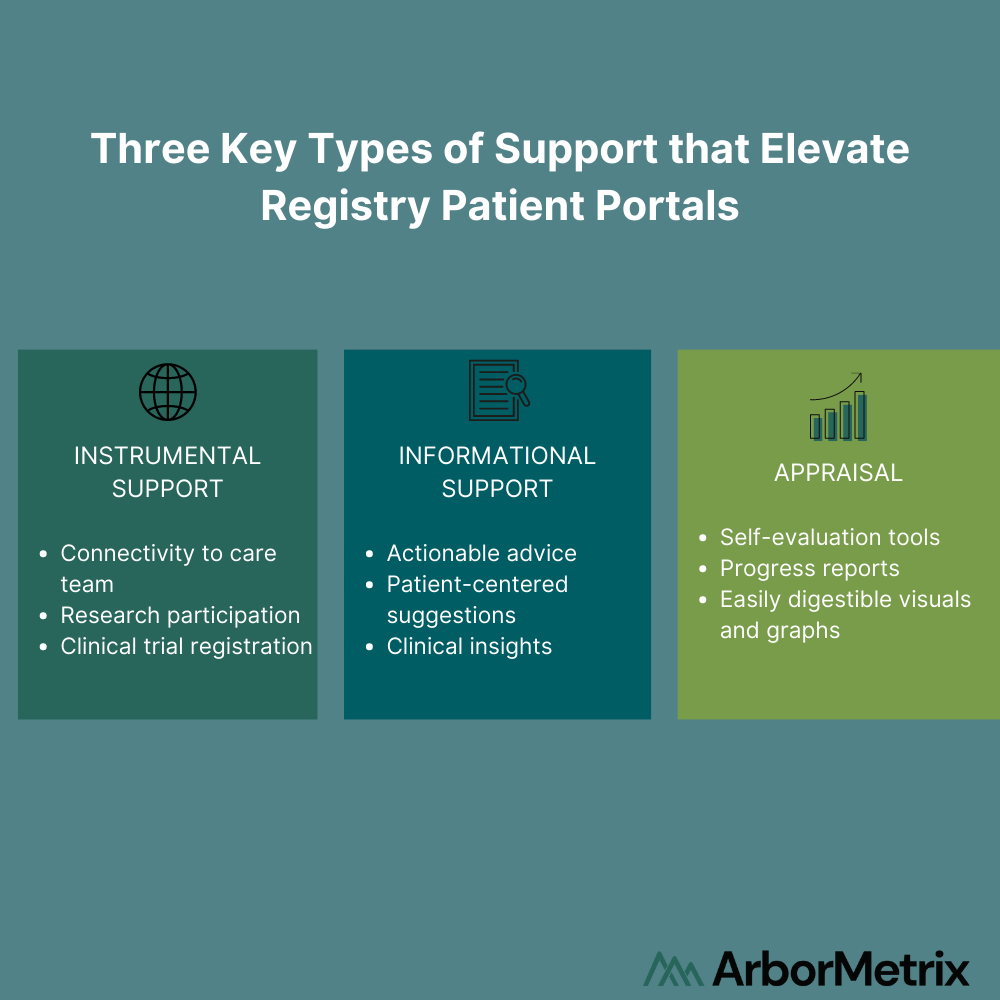
As described by Donna Cryer, JD, President and CEO of the Global Liver Institute, these patient-centric technologies give patients supportive communities and influential tools to elevate a patient’s voice and help them maximize their health.
3. Understanding a Global Pandemic
Monitoring, managing, and understanding COVID-19 was top-of-mind throughout several sessions. Registries are playing a central role in this.
Modern registries can address emerging health issues like the pandemic with rapid measurement and quick discoveries.
There are three key parts to doing this successfully:
- Determining the priorities and research questions a registry can uniquely answer.
- Using trusted data and advanced analytics to address critical issues.
- Leveraging a flexible data infrastructure to pivot at any time – modern clinical data registries are designed to evolve.
Several organizations are already leveraging their registries and data infrastructure to be proactive in measuring, monitoring, and addressing the COVID-19 pandemic. You can learn from them and find more strategies in our blog post “Best Practices for Clinical Registries with New Research Priorities.”
Registry Technology Should be People-Centric
Overall, digital transformations are about using technology to solve issues for people, not simply about using people to solve technology issues.
It is less about being technology-centric than it is about making technology people-centric. Registries are powerful tools that can be designed to address some of the most widespread health issues affecting people, while also engaging patients in innovative ways to improve their health experiences.
From defining the vision for a registry program to designing surveys and reports for clinicians and patients, we take a person-driven approach.
4 Ways Clinical Registries Deliver Value to Life Science Companies
 Medical specialty societies were founded on two key principles: knowledge sharing and the exchange of clinical insights to improve medical practice. That central task has evolved as societies use clinical data registries to serve diverse and important stakeholders who are also involved in ensuring optimal health outcomes.
Medical specialty societies were founded on two key principles: knowledge sharing and the exchange of clinical insights to improve medical practice. That central task has evolved as societies use clinical data registries to serve diverse and important stakeholders who are also involved in ensuring optimal health outcomes.
These clinical data registry stakeholders include:
- Clinicians
- Health Systems, Hospitals, and Provider Organizations
- Patients
- Public and Private Payers, and
- Life Science Organizations (Pharmaceutical and medical device companies)
Societies and their registries are vehicles to further data-driven care through collaboration with these health care stakeholders. New opportunities frequently arise for registries to add unique value through the data insights they provide — especially through partnerships with life science organizations.
Specifically, there are four common ways for registries to empower life science organizations with new understandings in patient outcomes. These opportunities further support real-time insights in clinical care.
- Patient Cohort Analytics
- Post-Market Surveillance
- Clinical Decision Support
- Registry-Based Clinical Trials
Let’s examine each to understand their value to industry and value to your mission.
1. Patient Cohort Analytics and Registries
Patient cohort analytics are useful in several ways. They provide analytic tools to facilitate activities like clinical trial enrollment and registry cohort comparison for research.
Registries transform raw data into tools that provide tremendous value to trial sponsors in two ways:
- Identification of individual patients who match a specific cohort of interest and meet clinical trial inclusion and exclusion criteria. This allows trial sponsors to expand their trial network beyond standard academic centers and into community care settings, and through rapid enrollment of trial participants.
- Creation of comparison cohorts of registry patients through propensity-score matching. This allows trial sponsors to allow for fair and accurate comparison between treatment cohorts within a trial external to the registry and non-treatment patients found within the registry.
2. Post-Market Surveillance and Registries
Patient registries are uniquely useful in their ability to facilitate post-market surveillance for three reasons:
- They advance post-market surveillance activities to help us better understand the real-world safety and effectiveness of procedures, treatments, and devices.
- They solve complex problems for device and pharma companies. These organizations in general are faced with complex barriers when seeking real-world data for purposes of research and development, quality improvement, or regulatory requirements.
- They deliver the comprehensive technology needed to build a registry that collects real-world data, transform it into real-world evidence, and make it accessible and useful.
Simply stated, registries provide real-time answers to common post-market surveillance questions, like:
- How is a device or drug actually used in real-world settings?
- What does the average patient look like?
- How does a product truly perform?
3. Clinical Decision Support and Registries
Clinical decision support tools convert retrospective registry data into powerful point-of-care tools with immediate impact on patient care.
Decision support tools are built to take the guess work out of trade-off decisions between treatment courses. With real-world data and a user-friendly interface, decision support apps are valuable resources. They enable clinicians and patients to prioritize outcomes and establish appropriate expectations.
At the same time, decision support tools can be designed to demonstrate the degree to which device or pharmaceutical factors drive outcomes. These tools create significant value for industry stakeholders and set the stage for value-based reimbursement.
4. Clinical Trials and Registries
Registry-based clinical trials (RBCTs) set the gold standard for creating value for multiple stakeholders.
RBCTs rely on the registry’s network of participating clinicians, their patients, and the foundational registry dataset. They identify participating investigators and clinicians, facilitate patient enrollment, and support the majority of data elements required for trial completion. Registries also capture specialized clinical trial data through custom patient surveys, electronic case report forms, and data mapping.
The process ultimately leads to a clinical trial completion that is much quicker and more cost-effective than traditional methods.
 Registry Data Partnership Readiness
Registry Data Partnership Readiness
There are a few key steps to determining your organization’s readiness for registry data partnerships with industry.
- Understand the market opportunity. To design an effective program, conduct market research to understand who would find value in your registry data, what products or therapies they have on the market, and how those products are valued.
- Assess your registry data. You’ll need to know what data in your registry would be valuable to medical device manufacturers or pharmaceutical companies. Assess those clinical situations where real-world registry data tracks either clinical practice or patient populations that can’t be easily studied via traditional trials.
- Validate your registry data quality. Data quality is important for any registry work. Before initiating registry-based clinical trials or making de-identified registry data available to industry, you want to ensure the data quality is regulatory-grade. Achieving this requires a thorough data quality analysis to assess data integrity across dimensions such as completeness, concordance, precision, and currency.
Developing Registries for Many Stakeholders
Registries are powerful tools for effectively generating new clinical insights for key stakeholders and creating meaningful partnerships with life science companies.
These stakeholder collaborations use registries to employ valuable data tools to evaluate and improve patient outcomes, and in the process, help to further support the operations of registries and their underlying missions.
ArborMetrix offers an industry-leading, proven registry solution that meets the needs of medical device and pharma companies, medical specialty societies, and clinicians.
Clinical Registries Are the Next Step for National Healthcare Improvement Initiatives
 In the alphabet soup of healthcare, often the initial drivers of large-scale initiatives are government reporting and regulatory requirements, like All Payer Claims Databases (APCD) and Health Information Exchanges (HIE). These requirements encourage interoperability and data sharing between stakeholders.
In the alphabet soup of healthcare, often the initial drivers of large-scale initiatives are government reporting and regulatory requirements, like All Payer Claims Databases (APCD) and Health Information Exchanges (HIE). These requirements encourage interoperability and data sharing between stakeholders.
These efforts aren’t new or news – but the past decade has focused on identifying assets, bringing the data in, and analytics that match patients across sources.
Government agencies at all levels (both in the U.S. and abroad) are moving into the next phase of this journey. They are going beyond data access and blending and focusing on using the data strategically to improve care and lower costs.
Registries Power Population Health Programs
When faced with a large population data set, it can be a challenge to target a single focus area that has both meaning and impact. Clinical data registries are a perfect example of macro-level data used for micro-level initiatives. When these targeted initiatives achieve measurable results, this leads to tremendous power for population health initiatives.
We’ve seen the role registries play in quality improvement successes at specialty-focused organizations. They’ve driven important and renowned innovations in care delivery. This has been accomplished through the symbiotic relationship between a culture of engaged physicians and the use of trusted data and powerful technology. The technology allows for a window into physician performance and patient outcomes.
When planning how to make a patient registry part of your population health program, there are two parts to consider:
- Registry Technology
- Registry Strategy
Part 1: Technology of Building a Clinical Data Registry for Population Health
A clinical data registry is built on the ingestion of real-world data and the transformation of that data through advanced analytics into actionable real-world evidence. Let’s break this process down into 3 key steps.

- Data Acquisition: Acquisition can include a broad spectrum of options. One option is machine-to-machine connections to EHRs, government assets, and other databases. There are also human-to-machine connections as needed for data entry from providers and patients. This includes more granular disease-specific elements and longitudinal outcomes outside of routine care visits.
- Data Assembly: Assembly can include validation and cleansing for quality, and transformation for analytic purposes. This includes creation of clinically specific measures, risk adjustment for fair case mix comparisons, patient matching, benchmark creation, predictive models, and more. This transformation is key to building trust in the data.
- Acting on Evidence: Leveraging evidence is facilitated by our intuitive and user-friendly tool, RegistryX. RegistryX provides visibility into all individual data elements attributed to patients, as well as aggregate reporting that provides deep insights into trends, patterns, and opportunities for change.
In large initiatives, so much time is spent on acquiring data that transforming it and utilizing it effectively are afterthoughts. While data is foundational and fundamental, a strong strategy behind the technology ensures a speed to value and long-term registry success.
Part 2: Strategy of Building a Clinical Data Registry for Population Health
A registry toolset needs to go beyond technology and data access and produce information of such quality that it can be relied upon to improve the standard of care across entire health systems, states, or countries.
At its strategic core, a registry is a very simple concept broken into 3 parts.
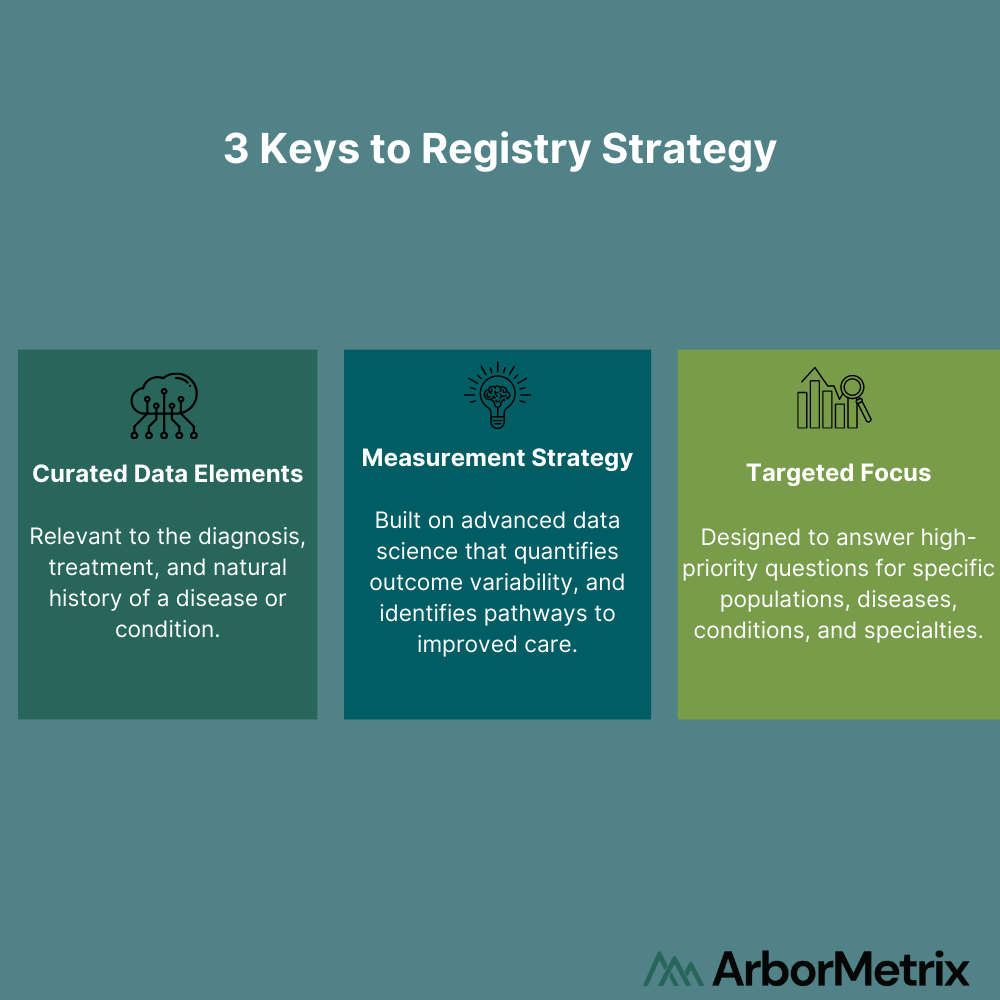 Curated Data Elements
Curated Data Elements
The curated data elements are considered and selected from the broad set of data assets available and used to create a defined Data Dictionary. While in some cases, gathering as many data elements as available has value (often the foundation of initiatives like HIEs and APCDs), most successful quality improvement initiatives only utilize a subset of these elements. Strategically curating these assets ensures the most relevant and meaningful elements are being collected, validated, and transformed for purpose-driven use in the context of specific diseases or conditions.
Measurement Strategy
The measurement strategy transforms data into information through the rigorous application of data science principles. These principles create trusted data assets that can quantify outcomes and identify the drivers of those outcomes. This trusted data gives, agencies, hospitals, or physicians the resources they need to better understand and improve care. This is the strategic heart of a registry – data that is trusted to enact important care delivery changes.
Targeted Focus
A targeted focus is the identification of high-priority questions your agency or organization needs to answer about the providers, patients, and processes under your influence. Starting with a focus ensures that you are pointed at achievable opportunities for change.
Think: reduce surgical site infection rates, not reduce mortality. This focus ensures that you are targeting true opportunity for improvement that will be measurable and repeatable across the system of care.
Operationalize Large Scale Quality Improvement
When you apply this strategic framework on top of strong registry technology, you can operationalize and catalyze large scale improvements in care delivery – across organizations, agencies, and around the world. To learn more about how to evaluate your registry technology, check out my post: 4 Technology Essentials for Patient Registries that Improve Care.
If you have any questions or would like to learn more about our clinical registry solutions, contact me at sheaton@arbormetrix.com.
What Is Healthcare Analytics and Why Is It Important?

Let’s face it: data is everywhere, especially in healthcare. From electronic health records to patient-reported outcomes, data piles up and can feel overwhelming without the tools and resources to make sense of it.
Applying big data analytics is the solution. Read on for an introduction to healthcare data analytics, including the types, uses, value, and potential future of data analytics in healthcare.
In this post we will cover:
- What Is Data Analytics in Healthcare?
- What Is the Role of Data Analytics in Healthcare?
- What Are the Types of Healthcare Analytics?
- How Is Healthcare Analytics Used?
- What Is the Value of Healthcare Analytics?
- What Is the Future of Data Analytics in Healthcare?
What Is Data Analytics in Healthcare?
In general, big data analytics is the practice of using analytical techniques to make sense of large sets of diverse data. [1] In healthcare, unwieldy data sets are the norm. A comprehensive data entry for a single patient could include everything from electronic health record data and physician notes to imaging, prescriptions, lab results, insurance, monitoring equipment output, and even social media posts.
Data sets like these are often impossible to analyze on more general, commonly used software platforms and hardware systems. [1] This is where the application of big data analytics in healthcare becomes a must-have instead of just a nice-to-have.
Advancing healthcare and improving patients’ lives requires both measurement and extensive analysis of these large sets of healthcare data to glean valuable, actionable insights. [1] Physicians, researchers, medical specialty societies, pharmaceutical companies, and every other healthcare stakeholder can then use these insights as jumping-off points for improvement.
What Is the Role of Data Analytics in Healthcare?
The role of data analytics in healthcare is clear: Pull the signal from the noise.
Whether you need to improve quality, advance research, manage risk, or anything in between, you have access to mountains of data. However, just having the data won’t do you much good if you don’t have a systematized way to organize, analyze, and interpret it.
This is one of the reasons why data analytics is so important in healthcare. By using analytical techniques, you can not only make sense of the past, but also chart a course for the future, for the benefit of the entire healthcare community.
What Are the Types of Healthcare Analytics?
One of the benefits of data analytics in healthcare is that there are many types you can use to answer many questions.
Let’s say you’re interested in readmission rates after surgical procedures. You’ll want to answer questions like: How did hospital readmission rates change over the past five years? What surgical procedures were associated with the highest readmission rates? What will readmission rates look like over the next year without any interventions? How could a potential intervention affect readmissions?
Healthcare analytics can help answer all of these questions. Let’s dive deeper into the four main types of healthcare analytics, their definitions, what questions they answer, and the potential limitations of each.
- Descriptive analytics uses data from the past to provide insights around trends or benchmarks, usually in the form of a dashboard. While descriptive analytics helps us understand what happened in the past, it is unable to provide strong insights to influence future health outcomes or provide foresight into potential future events.
- Predictive analytics uses modeling and forecasting to determine what is likely to happen next. Predicting the future is useful, but results are predicated on all conditions remaining the same. Predictive analytics is unable to provide insight into what might happen after an intervention or other change.
- Prescriptive analytics uses machine learning to suggest a course of action or strategy by taking in numerous inputs. Prescriptive analytics helps us understand what the effects of a specific action will be, but the inherent uncertainty and limited maturity of this type of analytics could lead to implementing suboptimal actions. [2]
- Discovery analytics uses machine learning to analyze raw data to determine interconnections, patterns, and outliers. Discovery analytics helps us understand what we need to explore further, but raw data can be incomplete or inaccurate, limiting its usefulness.
How Is Healthcare Analytics Used?
Data analytics can help improve healthcare for all industry stakeholders, from health systems and physicians to patients, pharmaceutical and medical device companies, and specialty societies.
The many uses of big data analytics in healthcare can be organized into four main buckets. Healthcare analytics can help your organization enhance its competitive position, improve quality, advance research initiatives, and manage risk and reporting.
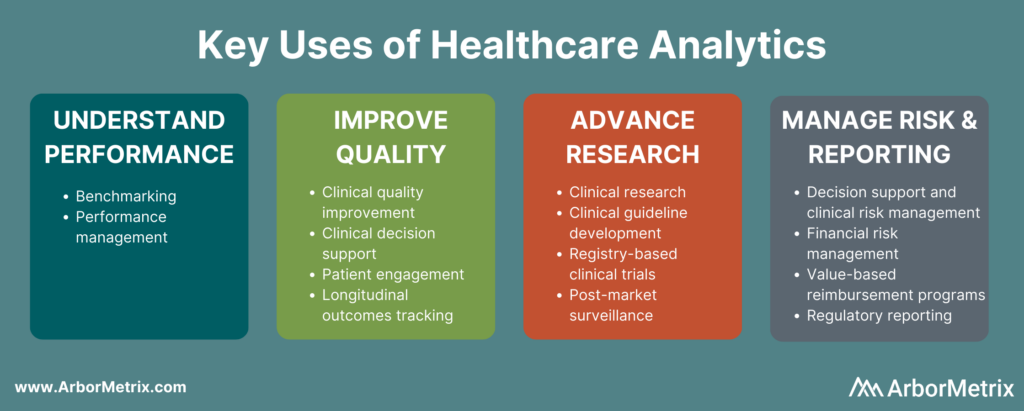
To tap into these key uses of healthcare analytics, you need cutting-edge software and a trusted process to take you from an unmanageable jumble of data to actionable, real-world evidence.
That process involves:
- Acquiring the data: Whether you use machine-to-machine data transfer, patient surveys, employed nurses abstracting data from case files, or all of the above, all data needs to be collected in one place.
- Transforming the data: Here, the data is cleaned, validated, and analyzed to answer research questions.
- Acting on the analytical insights: Leverage real-world evidence to reach your organization’s goals.
In addition, you’ll want to make sure your data analytics software solution is flexible enough to evolve with your needs, and that it’s built with high-level security features in place. That way, you’ll have everything you need to unlock the greatest possible value from your data.
What Is the Value of Healthcare Analytics?
Beyond its many uses, healthcare analytics provides real-world value to those who act on analytical insights. Below, you’ll find three key examples of health industry players that have reaped the benefits of using big data analytics in healthcare.
Example #1: Sound Physicians Mitigated Risk for BPCI-A
Sound Physicians is the largest hospitalist and critical care group in the United States and a leader in physician performance and analytics. Sound relies on an advanced analytic and IT infrastructure and workflow to improve care, manage performance, and monitor trends.
Notably, Sound focuses its clinical strategy and resources on value-based payment models such as the Bundled Payment for Care Improvement–Advanced (BPCI-A) program.
Sound’s partnership with ArborMetrix helps them leverage technology and analytics to drive real-time actions and accountability. We integrate clinical and financial performance data from Sound’s service lines and the organization’s 3,500+ clinicians onto a single healthcare analytics platform. This solution puts rich, clinically-relevant data into the hands of Sound’s regional operators and physicians to drive performance improvement and operational excellence.
Subsequently, acting on these insights and relying on advanced data science allows Sound Physicians to support physician-led decision making, the right clinical interventions, and an efficient management process.
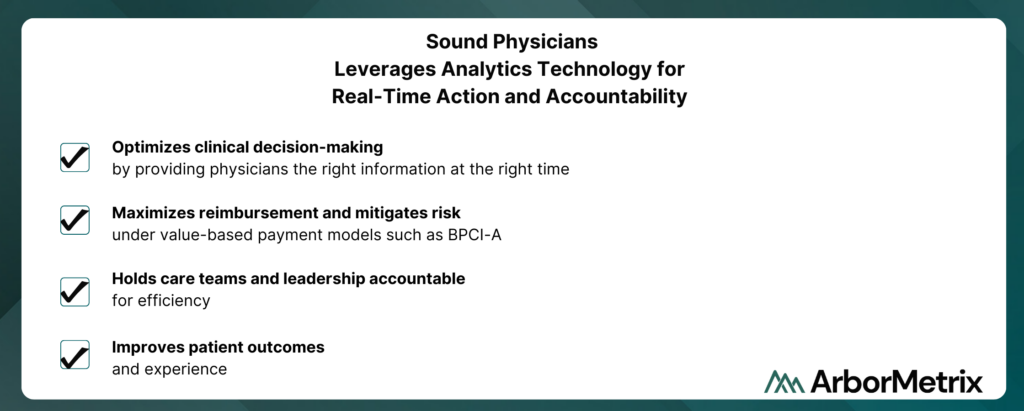 Example #2: The Michigan Bariatric Surgery Collaborative (MBSC) Reduced Post-Surgical Death Rates by 67%
Example #2: The Michigan Bariatric Surgery Collaborative (MBSC) Reduced Post-Surgical Death Rates by 67%
MBSC, a quality improvement collaborative funded by Blue Cross Blue Shield, leverages a powerful patient registry to improve bariatric surgery in Michigan. MBSC used the ArborMetrix platform to power outcomes calculators, patient-reported outcomes, and video surgical analysis, resulting in a 67% decrease in post-surgical death rates and $35 million in statewide savings, among other impressive results.
#3: The Extracorporeal Life Support Organization (ELSO) used a device registry to generate real-world evidence for ECMO
ELSO is an international non-profit consortium of healthcare centers and physicians dedicated to the development, evaluation, and improvement of ECMO (extracorporeal membrane oxygenation) and other innovative therapies for the support of failing organ systems. ELSO uses a comprehensive patient registry to advance ECMO research through real-world evidence and track the safety and effectiveness of devices and procedures in new patient populations.
To help ECMO device manufacturers fill their knowledge gap, ELSO leveraged this clinical registry to share data through a medical device registry. The device registry takes real-time data from more than 700 centers worldwide and transforms it to help manufacturers know how clinicians are actually using their devices, what the average patient looks like, and how their device performs in the real-world.
Recently, ELSO has also used its registry to track the usage and outcomes of ECMO for COVID-19 patients.
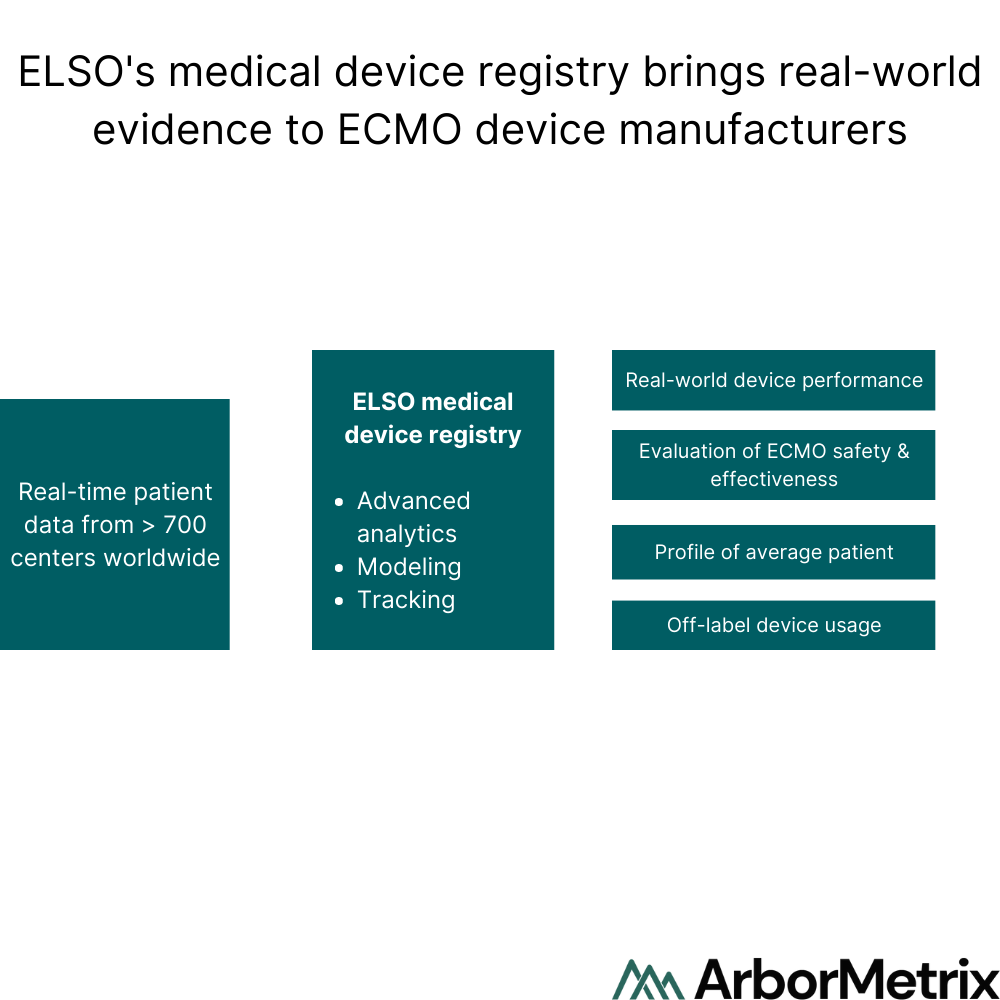
All three of these diverse examples show how motivated stakeholders can improve healthcare using big data analytics.
What Is the Future of Data Analytics in Healthcare?
New technologies are continuing to emerge that push the boundaries of how healthcare analytics can be used. From artificial intelligence to machine learning to natural language processing, the true future of healthcare is in wielding these technologies for greater impact.
Artificial intelligence (AI) refers to a collection of technologies that can autonomously think and adapt with intention. [3,4] In healthcare, AI can use input data to diagnose disease, structure clinical trial cohorts, and identify malignant tumors, among many other uses.
Machine learning and natural language processing are subsets of AI. Machine learning involves generating models to describe data. As more data is introduced, the algorithms adapt to the new information to create models that fit the data as accurately as possible. [3] Machine learning is often used in precision medicine in a predictive capacity—given a patient’s unique medical history, machine learning techniques can predict what treatment is most appropriate.
Natural language processing (NLP) uses various techniques to make sense of human-generated speech or writing. [3] NLP is especially useful for extracting information from patient records and classifying clinical documents.
This is just a taste of what’s in store for healthcare data analytics. With technology advancing at a rapid clip, new discoveries that can create even greater impact are inevitable.
-
Here's An Example of a Global Medical Device Registry that Delivers Real-World Evidence

Those who are held accountable for what happens in healthcare – whether a physician, care team member, pharmaceutical company, medical device manufacturer, or health system – need to understand what happens, why it happens, and how to improve.
But there’s a gap between what really happens in healthcare and what is “supposed” to happen. Clinical research, guidelines, and case studies tell us what is “supposed” to happen. Real-world data from the clinical setting or the patient themselves tells us what actually happened.
And it’s what actually happens that really matters.
Using Clinical Data to Fill the Medical Device Knowledge Gap
Addressing this gap requires collecting real-world data, transforming it into real-world evidence (RWE), and sharing it with those who can use it to advance care.
We can illustrate this with a relevant clinical example.
Extracorporeal membrane oxygenation, commonly referred to as ECMO, is a treatment that uses an artificial heart and lung to support the body when a person's own organs are too sick to do the job. ECMO itself will not cure a patient’s heart or lungs, but it buys time for patients to heal or for alternative treatments to be coordinated in cases of severe cardiac or respiratory failure.
Knowing what truly happens in clinical settings – having real-world evidence – is especially important here.
Physicians and ECMO practitioners need to have reliable data on how and when it is safe and effective to put patients on ECMO. But they are only part of the equation.
Given the complexity of care and the high rate of mortality and complications, ECMO care presents limitations for traditional clinical trials. This means despite decades of widespread use, until recently, ECMO has been largely performed off-label in the United States.
This is a crucial clinical knowledge gap for the companies manufacturing devices used in ECMO. They know anecdotally that their devices are being used in this way, but they do not have access to any data demonstrating the safety and effectiveness of their devices used in a clinical context.
Clinical Quality Registry for Physicians
To solve for their data and knowledge needs, physicians from across the globe have come together as part of the Extracorporeal Life Support Organization (ELSO). They collaborate, share data, and learn from one another through the ELSO Quality Registry.
The registry tracks use of medical devices for ECMO and collects real-world data on the patients who have received ECMO. It contains details on patient and device demographics, clinical information, patient outcomes, and adverse events. ELSO Registry data has been used to:
- Investigate high and low performing centers.
- Establish clinical best practice guidelines.
- Publish a wealth of detailed peer-reviewed research.
- Demonstrate the safety and effectiveness of current ECMO treatments.
- Improve when and how ECMO is provided in the future.
Medical Device Registry for Manufacturers
To help manufacturers fill their knowledge gap, ELSO leveraged its clinical Quality Registry to share data through a medical device registry.
The device registry, ELSO Evidence Explorer, takes real-time data from more than 700 centers worldwide and transforms it to help manufacturers know how clinicians are actually using their devices, what the average patient looks like, and how their device truly performs in the real-world.
Manufacturers leverage this data and review the usage, the incidence of mortality, and ECMO-specific complications where their devices were used as part of the circuit.
Using Registry Data for Real-World Evidence
ELSO’s long-standing registry is a rich data source with a lot of value. But it wasn’t enough to simply provide raw data exports to manufacturers. Creating a meaningful medical device registry required a few key steps.
1. Post-Market Surveillance of an Evolving Market
One of the greatest advantages of real-world registry data – that it is longitudinal – also presents unique challenges. Historical case data collected by ELSO provides invaluable benchmark information for current and new devices.
But this also means ELSO must continually work with industry stakeholders to make sure the devices being tracked within its registry accurately reflect an evolving market. As new devices and models hit the market, older devices are retired or devices and manufacturers are acquired, ELSO ensures registry data appropriately reflects these changes.
2. Conducting Data Discovery
ELSO conducted a data assessment to identify what data in its registry would be valuable to manufacturers, assessing in particular those clinical situations where real-world registry data tracks either clinical practice or patient populations that cannot be easily studied via traditional trial-based means.
For reasons described above, ECMO cannot be studied via a clinical trial, making this assessment process straightforward for ELSO. Other medical societies and registries should consider where their registry data tracks populations that are or cannot be studied through clinical trials.
Additionally, registries tracking patients with chronic conditions and longitudinal treatments can re-survey specific patient cohorts through patient-reported outcomes surveys. Ultimately, ELSO worked with manufacturers and regulators to inform how their registry data could meet the needs of ECMO manufacturers, and what reports they could provide.
3. Assessing Data Quality
Data quality is important for any registry work. For ELSO, this starts with automated validation of each data element, ensuring only appropriate data can be submitted to the registry. Additionally, they conduct randomized site audits to compare registry data to corresponding EHRs.
Using registry data with key stakeholders, including the U.S. Food and Drug Administration (FDA) and manufacturers, requires additional effort and coordination. ELSO works with these stakeholders to ensure they understand how and where data is collected. Accurately tracking how data elements have been added and removed from the registry over time is of particular importance.
4. De-Identifying and Analyzing Data
ELSO Registry data is de-identified to protect the privacy of participating institutions and patients. An automated analytic process also cleanses and transforms the real-world data collected into statistically validated real-world evidence. This ensures data can be used effectively by manufacturers and regulators while protecting registry participants.
5. Designing Dynamic Web-Based Reporting
Participating manufacturers review and interact with this RWE through a dynamic, web-based reporting tool. They can build their own custom reports and queries in real time - all in a way that protects the identities of participating institutions, patients and industry competitors.
Sharing Real-World Evidence Improves Outcomes
The way ELSO uses its registry to bridge the medical device knowledge gap with RWE is powerful. Other medical specialties and patient registries can do the same. Sharing insights from these clinically-rich data assets is one of the key ways to advance care and improve health outcomes for all.
For more information on our real-world evidence and registry solutions, contact us at info@arbormetrix.com.
To learn more about ELSO Evidence Explorer, visit elso-explorer.arbormetrix.com.


